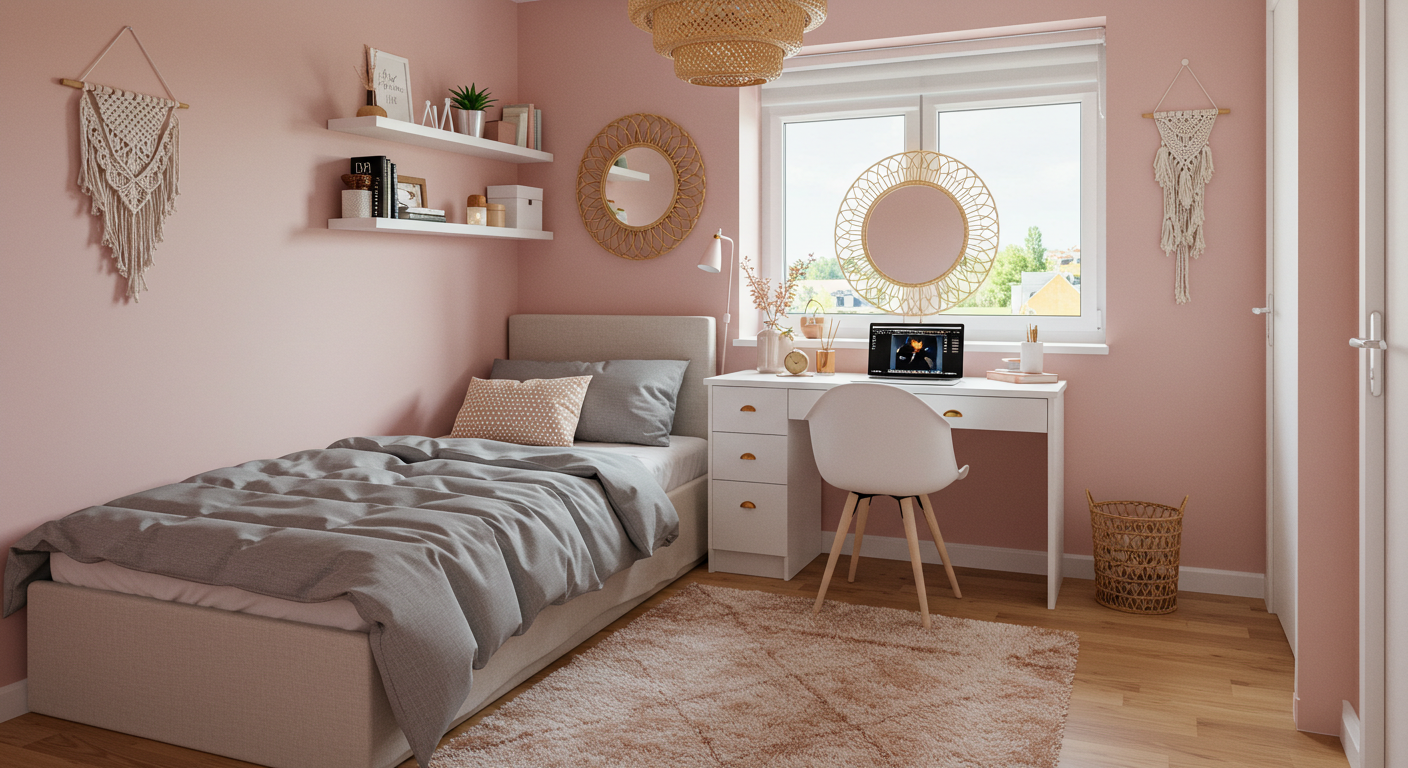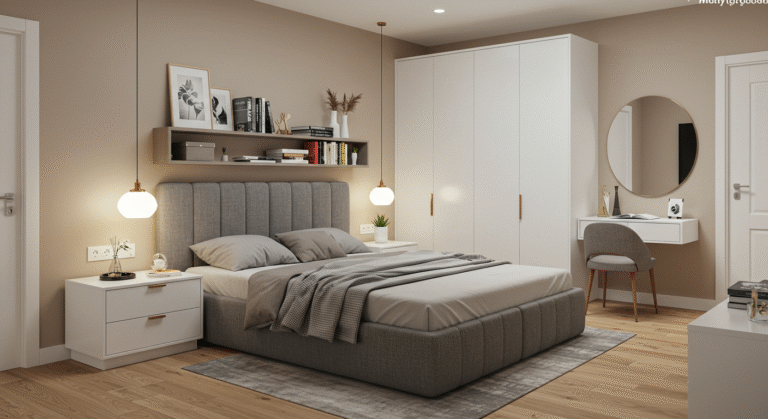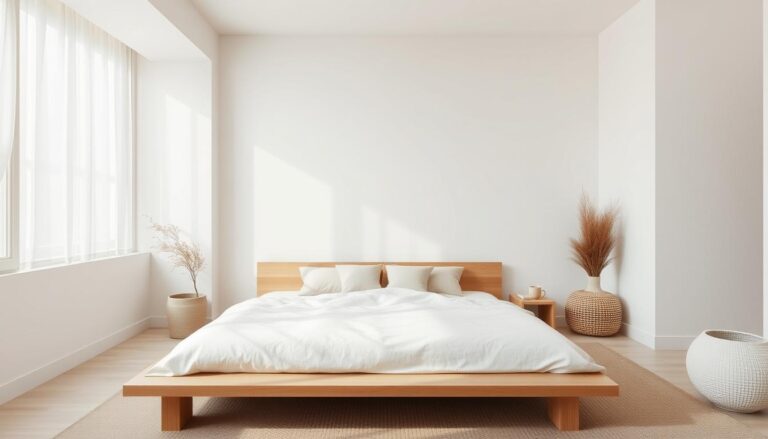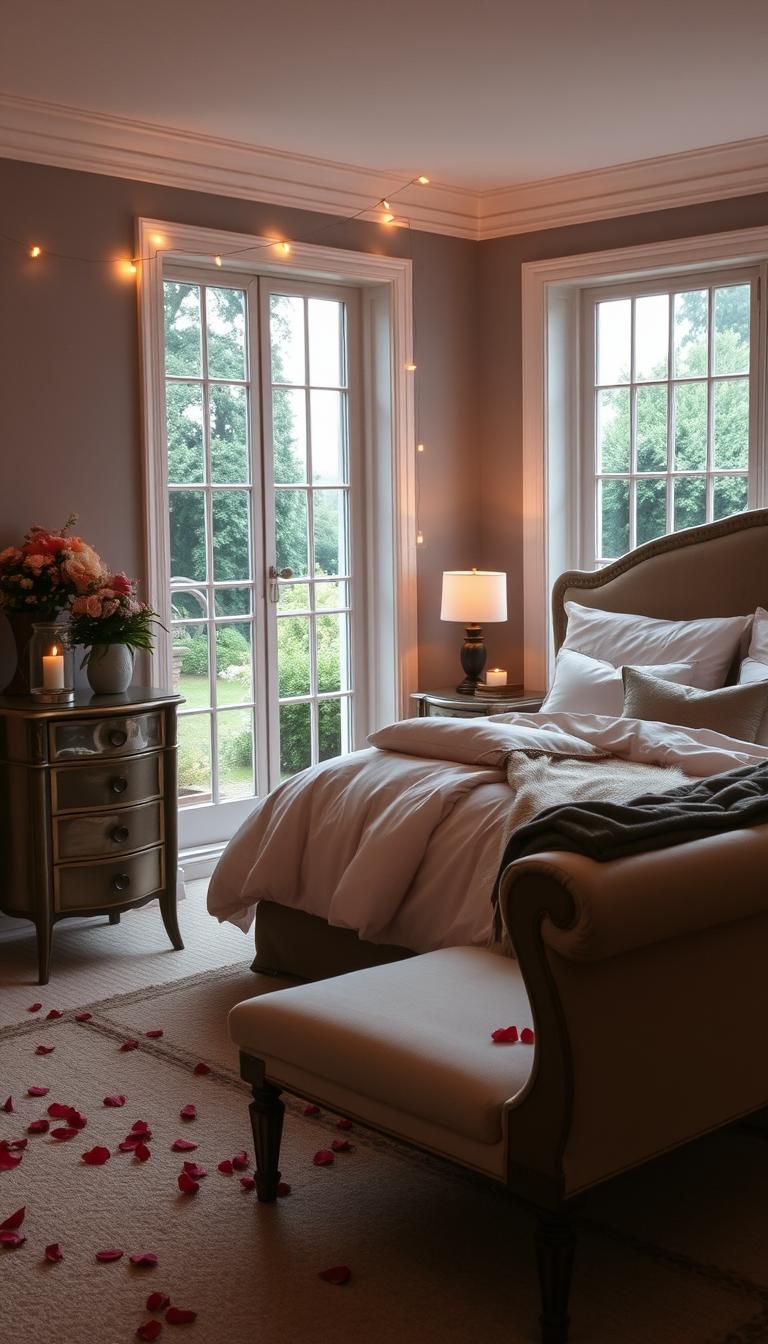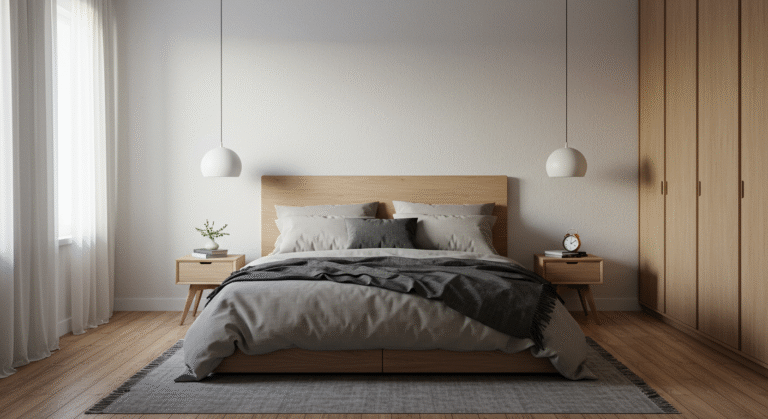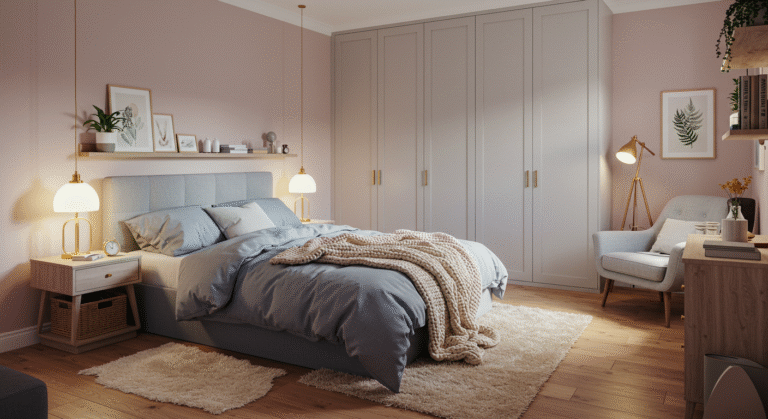13 Small Bedroom Ideas for Women: Maximize Your Space
“Your home should tell the story of who you are and be a collection of what you love.” – Nate Berkus. This philosophy drives my passion for reimagining compact spaces into personal sanctuaries where creativity and practicality thrive.
I’ve spent years studying how to blend style with functionality, especially in tight quarters. Drawing inspiration from experts like Kerrie Kelly Design Lab, I’ve seen how strategic design choices can turn even the tiniest room into a cozy retreat. Whether you’re working with limited square footage or awkward layouts, every inch holds potential.
This guide focuses on maximizing your space through clever storage solutions and multifunctional furniture. Think vertical shelving, under-bed organizers, and mirrors that amplify light. The goal? To create a room that feels both airy and deeply personal.
Your bedroom isn’t just a place to sleep it’s your daily reset button. By balancing aesthetics with smart organization, you’ll craft a space that reflects your personality while serving your needs. Let’s explore how to make it happen.
Key Takeaways
- Strategic design transforms tight spaces into stylish, functional retreats
- Vertical storage and multifunctional furniture maximize every inch
- Light-enhancing elements like mirrors create an airy atmosphere
- Expert-inspired layouts prioritize both aesthetics and organization
- Personal touches turn utilitarian spaces into meaningful sanctuaries
Understanding Your Small Space: Needs & Goals
Before picking paint colors or furniture, I inventory what truly matters in my daily bedroom experience. Designers like Kelly Wearstler emphasize “designing for how you live, not just how things look” a principle that guides my approach to compact areas. Start by asking: Do I need hidden storage for seasonal clothes? More natural light? A reading nook that doubles as guest seating?
I learned through trial and error that listing priorities prevents overcrowding. One client transformed her 10×12 room by focusing on three essentials: open floor space for yoga, a vanity with built-in drawers, and layered lighting. This edited mindset turns limitations into creative fuel.
Color plays a surprising role in perception. While many assume light tones work best, I’ve seen deep teal walls paired with gold accents make rooms feel intimate yet expansive. The key? Consistency. Matching curtain hues to wall colors eliminates visual breaks, while mirrored decor bounces light around corners.
Storage solutions should serve dual purposes. A vintage trunk becomes both a coffee table and linen holder. Floating shelves display books while keeping floors clear. As designer Emily Henderson notes:
“Every item in a tight room must earn its place through beauty or function—ideally both.”
Read Also: DIY Home Decor Ideas
Planning a Layout for Optimal Flow
Designing a compact living area requires a map, not just measurements. I start by sketching floor plans with clear walkways at least 24 inches wide to avoid bumping into furniture. This spatial awareness transforms cramped quarters into functional zones.
Prioritizing Essential Furniture
My rule? Every piece must serve two roles. A slim desk doubles as a side table, while an ottoman stores blankets. Interior designer Sarah Sherman Samuel advises: “Invest in fewer statement items that spark joy and serve practical needs.” This approach prevents overcrowding and elevates style.
Maximizing Vertical Space
Walls become secret storage allies. I install floating shelves above beds for books and decor, keeping floors clear. Consider these vertical solutions:
- Floor-to-ceiling cabinets with mirrored fronts
- Wall-mounted lighting instead of bulky lamps
- Hanging organizers behind doors
One client’s small bedroom gained 30% more usable space by combining a fold-down desk with her nightstand. This hybrid solution created a work area that disappears when not needed. Thoughtful layouts turn limitations into clever design opportunities.
Incorporating Multifunctional Furniture
When square footage shrinks, every furnishing becomes a strategic decision. I’ve found that pieces pulling double duty aren’t just practical they’re design statements. As West Elm’s design team notes: “The most impactful rooms balance utility with visual harmony, especially in compact layouts.“
Dual-Purpose Pieces for Every Corner
My studio apartment taught me to rethink traditional roles. A trunk now serves as both coffee table and winter coat storage. Consider these space-saving heroes:
- Ottomans with lift-up compartments for throw blankets
- Bookshelves that double as room dividers
- Benches with under-seat organizers
One client’s floating desk transformed into a vanity using flip-up mirrors and hidden makeup drawers. This approach maintains clean sightlines while packing serious functionality.
Read Also: Cozy Bedroom Ideas
Combining Desk and Nightstand Features
My favorite hack? Merging work surfaces with bedside essentials. A 24-inch-wide console holds my laptop by day and bedtime routine items at night. Key features to look for:
- Vertical storage cubbies for chargers and journals
- Pull-out trays that convert to laptop stands
- Built-in outlets for seamless device charging
Designer Justina Blakeney’s desk-nightstand hybrid proves that workspace needs don’t vanish in tight quarters they just require smarter solutions. By layering functions, you create zones without sacrificing style or floor space.
Choosing the Ideal Bed Frame & Design
A well-chosen bed frame can transform both the look and feel of your personal space. Through working with clients in studio apartments and loft conversions, I’ve seen how this central piece dictates spatial perception. As designer Athena Calderone observes: “Your bed isn’t just furniture it’s the anchor that balances proportion and purpose.“
Low Profiles for Vertical Expansion
I gravitate toward frames under 12 inches tall for their ability to emphasize vertical space. This creates an elevated ceiling illusion, especially when paired with floor-length curtains. Key considerations:
- Platform beds with integrated storage drawers
- Minimalist metal frames that let light flow beneath
- Upholstered bases in neutral tones to blend with walls
One client’s 10-foot ceiling felt twice as high after swapping her four-poster for a Japanese-style platform. The change made her string lighting installation more impactful.
Canopy Drama, Simplified
Four-poster structures work in tight spaces when executed thoughtfully. I recommend these clutter-free approaches:
- Airy bamboo frames instead of heavy wood
- Sheer fabric panels that stop at bed level
- Ceiling-mounted rods for floating canopy effects
A recent project used a powder-coated steel frame with linen drapes. The result? Visual height without sacrificing walkway space. By aligning the design with the room’s color scheme, we maintained a cohesive aesthetic.
Smart Storage Solutions for Small Bedrooms
Transforming tight spaces starts with reimagining storage possibilities. I design custom solutions that disappear into the architecture while holding essentials. As California Closets designer Melissa Galt advises: “Great storage feels intentional, not like an afterthought.“
Built-In Cabinets and Under-Bed Drawers
Floor-to-ceiling cabinets along one wall create vertical storage without bulk. I recently installed units with push-latch doors that mimic paneling—clients often mistake them for architectural features. Key benefits:
- Custom depths (6-14 inches) for specific items like shoes or linens
- Integrated lighting to highlight displayed decor
- Breathable materials like cane weaves for air circulation
Under-bed systems unlock 15+ cubic feet of hidden space. My go-to solutions include:
| Type | Capacity | Ideal For |
| Hydraulic lift beds | Seasonal clothing | Studios |
| Roll-out drawers | Daily essentials | Rental spaces |
| Modular dividers | Shoes/accessories | Shared rooms |
One client stored her entire winter wardrobe beneath a platform bed using vacuum-sealed bags. The streamlined look maintained her room’s airy vibe while tripling functional space. These strategies prove that smart storage isn’t about having more it’s about designing with precision.
Read Also: Living Room
Utilizing Wall-Mounted Options
Walls become your secret weapon in compact living areas. Interior designer Emily Henderson once told me: “Vertical surfaces offer untapped potential they’re the frontier of functional decor.” By shifting storage and lighting upward, you create breathing room below while maintaining personality.
Floating Shelves for Decorative Storage
I use staggered shelves to showcase favorite books and trailing plants. Their open design prevents visual heaviness. Three rules ensure success:
- Limit shelf depth to 8 inches for proportional looks
- Group items in odd numbers for balance
- Mix practical baskets with decorative objects
One client transformed her cluttered desk by mounting a trio of walnut shelves above it. The setup holds her journal collection while keeping workspace clear.
Wall Sconces to Save Floor Space
Overhead and table lamps often create tripping hazards. My go-to solution? Plug-in sconces with adjustable arms. They provide focused lighting without consuming surface areas. Consider these placements:
- Flanking beds instead of nightstands
- Above reading nooks at eye level
- Along narrow hallways as art accents
I recently installed swing-arm models in a 90-square-foot studio. The owner gained 18 inches of precious floor space previously occupied by bulky lamps. For renters, adhesive-mounted options offer temporary solutions without damaging walls.
When selecting wall-mounted pieces, measure twice and anchor securely. I prefer steel brackets for heavy items and discreet cleats for floating displays. This approach turns blank walls into dynamic features that enhance both form and function.
Designing with Color: Dark Hues & Neutral Palettes
Color wields transformative power in compact interiors. My breakthrough came when I painted a client’s 9×12 room in charcoal gray with pearlescent undertones. The space felt instantly sophisticated rather than confined. Darker shades add depth when balanced with reflective surfaces and strategic lighting.
Embracing Ombre and Monochromatic Schemes
Vertical ombre effects became my secret weapon for height illusion. I blend navy at the base into pale sky tones near the ceiling. This gradient draws eyes upward while maintaining a cohesive look. For monochromatic spaces, I layer three shades of the same hue. A recent project used dove gray walls, slate bedding, and mercury glass lamps.
Neutral palettes don’t mean boring. I mix warm taupes with crisp whites, adding texture through woven throws and velvet pillows. Designer Nate Berkus once noted: “Neutrals act as a canvas they let your favorite decor pieces sing.” This approach works wonders in rooms pulling double duty as offices or lounges.
Accent lighting elevates color choices. I position LED strips along crown moldings to wash dark walls with soft glow. In one studio, directional sconces highlighted a terracotta accent wall, making the space feel 20% larger. Always test paint samples under both natural and artificial light colors shift dramatically.
Balance boldness with restraint using the 60-30-10 rule: dominant neutral, secondary hue, and pops of contrast. My fail-safe combo? Warm white walls (60%), sage green textiles (30%), and brass fixtures (10%). This formula creates harmony without visual overload.
Embracing Patterns & Textures for Visual Expansion
Patterns became my secret weapon for transforming cramped areas into dynamic spaces. Through trial and error, I discovered how strategic repetition tricks the eye into perceiving expanded dimensions. One client’s 8×10 sanctuary gained visual depth using a single botanical print across an entire wall a technique called pattern drenching.
Pattern Drenching Techniques
Bold prints work best when anchored by neutral elements. I balance large-scale florals with matte textures like linen bedding or rattan rugs. Designer Justina Blakeney emphasizes: “A dominant pattern needs breathing room surround it with solids to prevent visual chaos.” This approach maintains focus while stretching perceived boundaries.
Read Also: Mobile Home Landscaping
Texture layering adds dimension without clutter. Consider these combinations:
| Pattern Type | Visual Effect | Best Use |
| Geometric | Creates rhythm | Accent walls |
| Floral | Softens edges | Window treatments |
| Striped | Elongates surfaces | Area rugs |
Natural materials like wood bring warmth to pattern-heavy spaces. I recently framed a vibrant wallpaper wall with oak molding the organic grain tempered the bold print while adding tactile interest. This fusion of elements makes design schemes feel intentional rather than overwhelming.
When executed thoughtfully, patterns unify disparate decor elements. A client’s scattered collectives gained cohesion through a navy trellis-print headboard that echoed her rug’s subtle diamond motif. The key lies in repeating colors rather than identical prints a trick that maintains harmony without monotony.
Lighting Strategies to Enhance Ambiance
Layered illumination transforms cramped quarters into inviting retreats. Through client projects and personal experiments, I’ve learned that lighting works best when combining three elements: ambient glow, task-focused beams, and decorative accents. Interior designer Kelly Hoppen puts it perfectly: “Lighting is the jewelry of a room it elevates everything it touches.“
Suspended Fixtures and Ambient Options
Overhead pendants became my go-to solution for saving space while adding drama. A client’s 80-square-foot studio gained architectural interest with a clustered trio of paper lanterns. Their soft diffusion eliminated harsh shadows, making the ceiling feel higher. Key benefits of elevated fixtures:
- Draw eyes upward to enhance vertical perception
- Free up surface areas for functional items
- Create focal points without wall-mounted decor
I balance suspended lighting with plug-in sconces and LED strips. In my own home, directional wall lights flank the bed for reading, while hidden under-cabinet strips illuminate display shelves. This tiered approach supports both late-night work sessions and relaxed evenings.
Through trial and error, I developed this lighting formula:
| Layer Type | Purpose | Examples |
| Ambient | Overall illumination | Flush mounts, track lights |
| Task | Specific activities | Adjustable desk lamps |
| Accent | Visual interest | Picture lights, rope LEDs |
Experts agree: avoid relying solely on overhead fixtures. I recommend dimmers for controlling intensity throughout the day. This flexibility lets you morph a bright room into a cozy nest with one slider adjustment.
Small Bedroom Ideas for Women
Designing intimate spaces requires balancing elegance with everyday practicality. My approach centers on solutions that spark joy while serving real needs like a client’s jewel-box reading nook hidden behind custom drapery. “Feminine design isn’t about frills,” notes designer Athena Calderone. “It’s about creating environments that empower through beauty and purpose.“
Strategic material choices make tight areas feel luxurious. I combine velvet throw pillows with satin-bound edge bedding, adding depth through contrasting textures. A recent project used pearlescent wall panels to amplify natural light while maintaining softness proving glamour needn’t sacrifice function.
Three elements define successful feminine spaces:
- Soft textiles that invite touch without overwhelming
- Smart storage disguised as decor (think bejeweled trinket trays)
- Layered lighting with dimmable options for mood shifts
One apartment makeover transformed a 9×11 room using these principles. We installed floating makeup stations inside wardrobe doors and used translucent room dividers to separate dressing areas. The result? A sanctuary that feels expansive yet intimately personal.
Every choice should reflect individual personality. Whether through framed poetry collections or heirloom lace repurposed as wall art, these details turn utilitarian spaces into expressions of self. As you curate your retreat, ask: Does this item solve a problem while making my heart sing? That intersection is where true style lives.
Integrating Vintage and Contemporary Decor
Blending eras in design creates spaces that tell stories beyond trends. I discovered this truth while restoring a 1920s vanity for a client’s sleek, modern home. The juxtaposition of carved wood against concrete walls became the room’s focal point proof that time-worn pieces add soul to minimalist interiors.
Mixing Old Treasures with Modern Pieces
Start with one statement vintage item. A mid-century lamp base paired with a geometric shade bridges decades effortlessly. Designer Shelby Gerard recommends: “Anchor eclectic mixes with neutral backdrops let each piece command attention without visual competition.” This approach maintains balance in compact areas.
I often layer textures to unite different eras. Consider these combinations:
Read Also: Drawing Room
- Velvet upholstered chairs beside wrought-iron side tables
- Brass-framed mirrors reflecting abstract wall art
- Antique Persian rugs under streamlined platform beds
Proportion matters most. I scale vintage finds to contemporary furniture a petite Art Deco dresser complements a low-profile bed without overwhelming the space. Contrast finishes intentionally: polished nickel hardware pops against distressed wood, while matte black frames modernize oil paintings.
Through client projects, I’ve seen how curated blends personalize home environments. One apartment’s gallery wall merged family heirlooms with digital prints, creating a dialogue between generations. These layered decor schemes prove that great design transcends time periods when guided by intentionality.
Innovative Storage: Repurposing Furniture & Closets
Reimagining everyday pieces unlocks hidden potential in compact environments. I approach storage as a design challenge how to create systems that disappear into the background while holding life’s essentials. As designer Emily Henderson notes: “The best organizational solutions feel like natural extensions of your space.“
Transforming Closets Into Multiuse Areas
Standard reach-ins become functional zones with strategic upgrades. I converted a client’s 4-foot closet into a hidden work station using these steps:
- Installed fold-down desk surface on back wall
- Added LED strip lighting under shelves
- Used tension rods for hanging supply organizers
The result? A fully functional office that disappears behind sliding barn doors. For beauty enthusiasts, shallow cabinets make ideal makeup stations when lined with magnetic boards for brushes.
Under-Bed and Overhead Storage Ideas
Vertical real estate often goes underutilized. My favorite solution pairs hydraulic bed frames with ceiling-mounted racks:
| Zone | Solution | Capacity |
| Under-bed | Divided rolling bins | 8-12 pairs of shoes |
| Overhead | Fabric-covered cubbies | Seasonal linens |
| Corners | Triangular hanging units | Handbags/hats |
I recently helped a client store 90% of her winter wardrobe beneath the bed using vacuum-sealed bags. Matching woven bins maintained visual cohesion while maximizing function. For renters, adhesive hooks on closet ceilings create instant storage for bulky items.
These ideas prove that creative repurposing elevates both form and function. By viewing furniture through a dual-purpose lens, you craft spaces that adapt to your needs without sacrificing style.
Utilizing Natural Elements for a Serene Atmosphere
Biophilic design principles have reshaped how I approach compact living areas. Integrating nature into home environments isn’t just trendy it’s a proven method to reduce stress and enhance air quality. Studies show rooms with natural elements can lower heart rates by 8% within minutes of entry.
I start by selecting low-maintenance plants that thrive in indirect light. Snake plants and pothos vines become living decor while purifying the air. Their trailing leaves add soft movement to static design schemes, creating dynamic visual interest without clutter.
Organic Materials as Tactile Anchors
Wood accents ground modern interior spaces with warmth. A floating walnut shelf holds my favorite ceramics, its grain patterns echoing nature’s imperfections. Designer Ilse Crawford advocates “using raw materials to counterbalance synthetic surfaces” a philosophy I apply through jute rugs and linen curtains.
Lighting plays a crucial role in showcasing these elements. I position LED strips behind potted ferns to cast leafy shadows on walls at night. This technique transforms the room into a tranquil oasis after sunset.
Three subtle ways to incorporate nature:
- Group ceramic vases with dried grasses near windows
- Use rattan baskets as under-bed storage
- Layer stone-textured throw pillows on neutral bedding
These touches maintain an uncluttered space while fostering connection to the outdoors. The result? A calming retreat that feels both curated and effortlessly organic.
Read Also: College Dorm Aesthetic
Customizing Your Space with Personal Style
Personal expression thrives where limitations exist. My journey with DIY projects began when a client’s tight budget collided with her bold vision. We transformed plain walls into artistic statements using materials that whispered her story—proving even modest spaces can radiate individuality.
DIY Headboard and Accent Wall Ideas
Creating a custom headboard became my favorite way to anchor a room’s style. For one project, we repurposed thrifted shutters into a textured backdrop. The result? A bedside focal point that cost under $50. Design expert Emily Henderson praises such projects: “Handmade elements add soul you can’t buy from catalogs.“
When selecting materials, consider both texture and tone. I lean toward:
- Fabric remnants for tufted designs
- Reclaimed wood for rustic warmth
- Metallic paints for modern edge
Accent walls offer similar impact with less effort. A recent ombre paint technique I tested used three shades of mauve. The gradient effect visually stretched the wall while reflecting the homeowner’s love for sunset hues.
| Material | Cost | Style Impact |
| Peel-and-stick wallpaper | $35/roll | High |
| Stenciled patterns | $15 kit | Medium |
| Floating shelves + art | Variable | Customizable |
These projects prove decor doesn’t require grand gestures. Start small paint a geometric shape behind your bed or frame fabric with curtain rods. Your home becomes a canvas where every brushstroke declares “this is me.“
Budget-Friendly Decor and Design Solutions
Creating a stylish haven doesn’t require endless funds it demands strategic choices. I’ve discovered that budget-conscious design thrives when you focus on versatile pieces and creative repurposing. Retailers like Urban Outfitters offer midcentury-inspired furniture with compact footprints, while Room & Board’s teen collections provide scaled-down solutions perfect for tight layouts.
Smart Shopping Tips for Small Furniture
Hunt for pieces that serve multiple roles. A narrow dresser can store clothes and double as a vanity with a mounted mirror. Look for these features:
- Convertible designs (daybeds with trundles)
- Modular shelving systems
- Nesting tables that tuck away
I recently found a lofted bed with built-in drawers at 40% off during seasonal sales. Always measure doorways and staircases before purchasing oversized items often incur costly returns.
DIY Decor to Maximize Savings
Transform thrift store finds into custom treasures. My $20 side table became a chic nightstand after sanding and matte spray paint. Try these projects:
| Item | Upgrade | Cost |
| Wooden crates | Stacked shelves | $12 |
| Fabric scraps | Wall tapestry | $8 |
| Mason jars | Vanity organizers | $5 |
Use removable wallpaper samples to create accent zones behind floating shelves. These temporary solutions let you experiment without commitment, proving great design stems from imagination more than expense.
FAQ
How do I prioritize furniture in a tight layout?
I start by selecting only essentials like a bed frame and one storage piece. Then, I use vertical space with wall-mounted shelves or tall cabinets to avoid floor clutter.
Can a desk double as a nightstand?
Absolutely! I’ve used slim desks with built-in drawers or open shelves for bedside storage. Opt for compact designs that blend seamlessly into the room’s flow.
What bed frame styles work best for low ceilings?
Low-profile platform frames or minimalist designs with clean lines create an airy feel. I avoid bulky headboards and focus on materials like light wood or metal to keep it open.
How do I add storage without sacrificing style?
Built-in cabinets or under-bed drawers are my go-to. I also love floating shelves for displaying decor while keeping essentials organized pair them with woven baskets for texture.
Are dark colors suitable for tiny spaces?
Yes! I’ve used deep hues like navy or charcoal on accent walls to add depth. Pair them with neutral bedding and mirrors to balance the mood without shrinking the room visually.
What lighting tricks make a room feel larger?
I layer ambient lighting with wall sconces or pendant lamps. Avoid floor lamps that eat up space opt for fixtures that draw the eye upward, like a statement chandelier.
How can I mix vintage and modern decor?
I balance old treasures, like a retro dresser, with sleek, contemporary bedding. Keep the color palette cohesive to tie different eras together without overwhelming the space.
What’s a budget-friendly way to personalize my room?
DIY projects! I’ve crafted accent walls with removable wallpaper or painted geometric patterns. Thrift stores are also great for unique, affordable pieces like vintage mirrors or side tables.
Conclusion
Transforming compact living areas requires equal parts vision and strategy. Through years of collaborating with design experts, I’ve witnessed how intentional choices elevate cramped quarters into curated sanctuaries. Every solution we’ve explored from vertical storage to adaptive furniture proves limitations spark innovation.
Your bedroom holds untapped potential. Strategic layouts turn awkward corners into reading nooks, while layered lighting redefines ambiance. Remember that multifunctional pieces aren’t compromises they’re opportunities to craft spaces reflecting your evolving needs.
Details make the difference. A well-placed mirror amplifies natural light; textured bedding adds depth without clutter. As Nate Berkus reminds us: “Your home should rise up to greet you.” This philosophy shines brightest in modest rooms, where each element serves purpose and personality.
Now’s the time to reimagine your environment. Start with one wall or a single storage challenge. Let these ideas guide your journey toward a space that balances beauty with practicality. Your perfect retreat awaits ready to unfold its wings.

